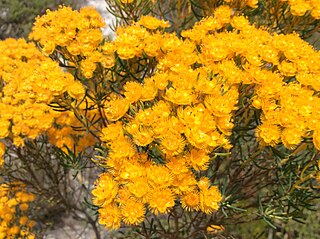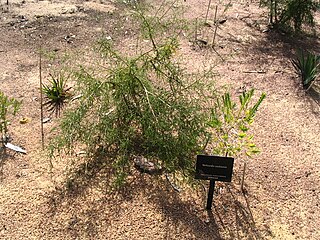
Verticordia nitens, commonly known as Christmas Morrison and other names, is a flowering plant in the myrtle family, Myrtaceae and is endemic to the south-west of Western Australia. The Noongar peoples know the plant as kotyeningara. It is an upright shrub with glistening and perfumed flower heads that appear between October and February. The small compact and erect flowers have been noted for their beauty. Although it occurs in areas near Perth, Morrison featherflower is not classed as rare or endangered because it still occurs in large populations, although its numbers have undoubtedly been reduced as a result of urban development.

Verticordia eriocephala, commonly known as lambswool, and common, native or wild cauliflower is a flowering plant in the myrtle family, Myrtaceae and is endemic to the south-west of Western Australia. It is a shrub with one densely branching, spreading main stem, small leaves and dense heads of creamy-white flowers, giving rise to the common names "lambswool" and "cauliflower". It is widespread over its range but becoming less common because of land clearing and illegal collecting of the flowers.
Verticordia amphigia commonly known as pixie ears is a flowering plant in the myrtle family, Myrtaceae and is endemic to the south-west of Western Australia. It is usually an open, much-branched shrub with narrow leaves and yellow flowers which sometimes produce a "sea" of colour in the wild. The flowers are surrounded by boat-shaped bracteoles which give the plant both its common and scientific names.
Verticordia argentea is a flowering plant in the myrtle family, Myrtaceae and is endemic to the south-west of Western Australia. It is an erect, open shrub with almost circular leaves and scented, pink and white flowers. It usually grows in sand and is found near Eneabba.
Verticordia bifimbriata is a flowering plant in the myrtle family, Myrtaceae and is endemic to the south-west of Western Australia. It is an open shrub with small leaves and spikes of pink flowers.
Verticordia patens is a flowering plant in the myrtle family, Myrtaceae and is endemic to the south-west of Western Australia. It is a shrub with linear, pointed leaves and faintly scented, pale yellow flowers in open heads on the ends of the branches. It is fairly common in a small area south of Badgingarra.

Verticordia halophila, commonly known as salt-loving featherflower, or salt-loving verticordia, is a flowering plant in the myrtle family, Myrtaceae and is endemic to the south-west of Western Australia. It is an erect, bushy shrub with small, crowded, thick leaves and spikes of red and pink flowers in spring.

Verticordia sect. Chrysorhoe is a section that describes three shrub species in the genus Verticordia. The section is one of seven in the subgenus, Verticordia subg. Chrysoma. The three species in this section are inflexible, upright shrubs usually no taller than 2 m (7 ft). They have needle-like leaves and their flowers are arranged corymb-like, sometimes densely on the ends of the branches. The flowers are orange, gold-coloured or yellow and the petals have toothed margins, the anthers have a flattened, swollen appendage and the staminodes are narrow.

Verticordia cooloomia, commonly known as Cooloomia verticordia, is a flowering plant in the myrtle family, Myrtaceae and is endemic to the south-west of Western Australia. It is an open, spreading shrub with large heads of sharply scented yellow flowers and is only known from areas in and near to the Cooloomia Nature Reserve, near the Murchison River.

Verticordia fastigiata, commonly known as mouse featherflower, is a flowering plant in the myrtle family, Myrtaceae and is endemic to the south-west of Western Australia. It is a prostrate or low shrub with small, club-shaped leaves and mouse-scented flowers which vary in colour from golden-yellow and orange to dark red.
Verticordia centipeda is a flowering plant in the myrtle family, Myrtaceae and is endemic to the south-west of Western Australia. It is a shrub with a single stem at the base, small crowded leaves and greenish-pink flowers with a silvery fringe, in spike-like groups on the ends of the branches. It is common in areas around Geraldton.
Verticordia dasystylis is a flowering plant in the myrtle family, Myrtaceae and is endemic to the south-west of Western Australia. It is a small shrub, with many stems at its base, oblong leaves and scented, fluffy, yellow and white flowers. There are three subspecies, each of which has a priority conservation status.
Verticordia fragrans, commonly known as hollyhock verticordia, is a flowering plant in the myrtle family, Myrtaceae and is endemic to the south-west of Western Australia. It is an openly branched shrub with egg-shaped leaves and spikes of sweetly scented, pink and white flowers in spring and early summer.
Verticordia integra, commonly known as plastic verticordia, is a flowering plant in the myrtle family, Myrtaceae and is endemic to the south-west of Western Australia. It is a shrub with only a few branches, with very thick oblong to egg-shaped leaves and heads of shiny golden-coloured flowers in late spring.

Verticordia laciniata is a flowering plant in the myrtle family, Myrtaceae and is endemic to the south-west of Western Australia. It is an openly branched shrub with linear, slightly hairy leaves and heads of scented, bright yellow flowers which turn red then bronze-coloured as they age.
Verticordia luteola is a flowering plant in the myrtle family Myrtaceae, and is endemic to the south-west of Western Australia. It is a more or less openly branched shrub with crowded leaves on its side branches and spikes of pale yellow or bright pink flowers which turn cream to brownish as they age. This verticordia is a summer-flowering species.
Verticordia minutiflora is a flowering plant in the myrtle family, Myrtaceae and is endemic to the south-west of Western Australia. It is a bushy shrub with small, crowded, cylindrical leaves and groups of white to pale pink flowers in summer and autumn. As suggested by its botanical name, it has the smallest flowers of any verticordia.
Verticordia mitodes is a flowering plant in the myrtle family, Myrtaceae and is endemic to the south-west of Western Australia. It is a shrub with a single, highly-branched main stem, small leaves and small spikes of magenta-coloured flowers in late spring.
Verticordia polytricha, commonly known as northern cauliflower, is a flowering plant in the myrtle family, Myrtaceae and is endemic to the south-west of Western Australia. It is an erect, bushy shrub with linear leaves and dense heads of white flowers in late spring and summer.
Verticordia vicinella is a flowering plant in the myrtle family, Myrtaceae and is endemic to the south-west of Western Australia. It is a shrub with narrow leaves and groups of small, scented, pink or pale yellow flowers, growing near Esperance and in the Cape Arid National Park.







